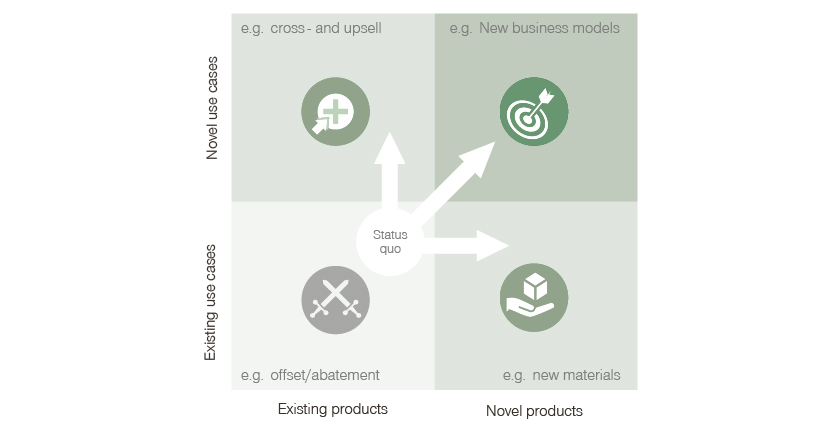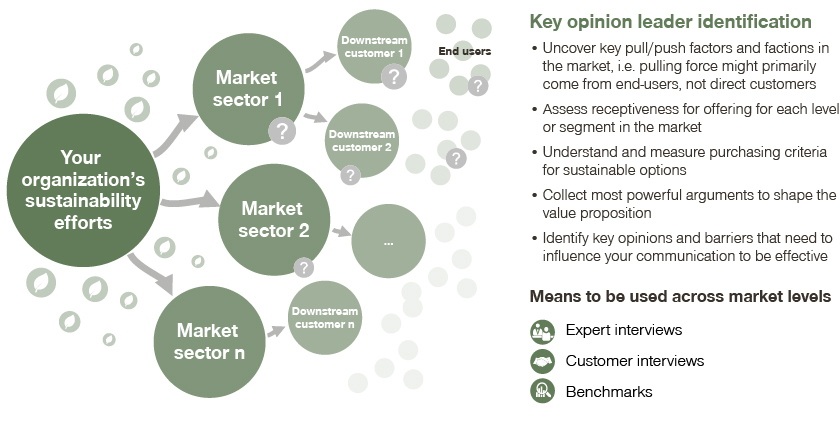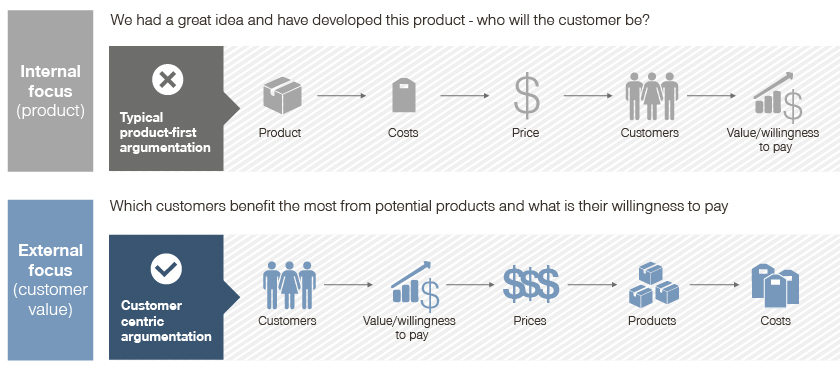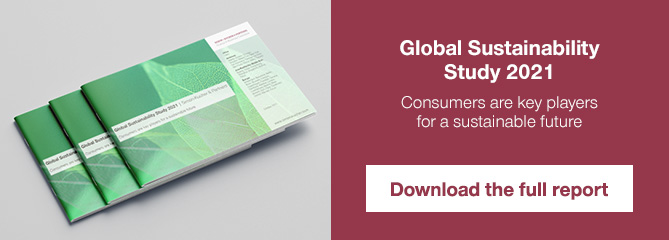As resources and input materials become increasingly expensive – through scarcity or regulation – companies can accelerate their sustainability efforts and turn such situations into opportunities. Product innovation is key and we have summarized the four fundamental questions to pose when (re-)imaging existing product and service portfolios for sustainability. This post describes the second phase – innovate – in our series on sustainability business transformations.![]()
A common initial step to making a company’s products or services more sustainable is to use alternative materials or create tweaked designs, which are sold alongside the existing portfolio and through the traditional sales channels. Why can this lead to problems? We regularly see companies applying legacy or traditional marketing and pricing strategies which are not adapted to account for the sustainability benefits. This can result in the new options not performing as expected and not reaching their commercial targets. Consequently, investments may be diverted away from sustainability.
Companies need to understand the value they create for customers through the decrease in environmental footprint, properly charge for it, and tailor their communication and value selling arguments accordingly. In this second phase (Innovate) of our sustainability transformation framework, we describe which best practices companies can leverage to create the most impact from their sustainability solutions and take the next step in their transformation journey.
Key question #1: Which elements of sustainability are valued most by consumers and can any new segments be reached?
An organization needs to establish a baseline understanding of the market dynamics. However, when it comes to sustainability, many companies feel a lot of uncertainty: Who are the customers that value sustainability and which are the segments that should influence a company’s decision making? What are their specific preferences regarding this topic? Using the premises and baseline assumptions outlined in your sustainability strategy, you can use the following steps to identify what customers really value:
- The starting point is to establish a cross-departmental task force to conduct an internal review and break down historical thought silos. Instead of falling back on traditional strategies and idea patterns, previous assumptions need to be actively challenged, e.g., by using the “5 Whys” technique to identify the root cause of the problem at hand and to determine the key market players or customers involved.
![graph]()
- Next step is to conduct interviews or focus groups from your top or target customers. However, level-1 alone might not be sufficient, as it can be useful to explore further down the supply-/value-chain and speak with level-2, -3, or -4 customers as well as industry experts to finally conclude who the decision makers or key influencers are and what they value.
- Once you understand the fundamental market dynamics, you can use the information to tailor your communication, use it as input for your value-based pricing of existing products and services as explained below, and also as input for the framework on how to monetize sustainable innovations, which we will describe in the next article of our blog series.
Our recent study involving 10,000 participants has shown that preferences around sustainability can vary between countries, demographics and industries. A sound understanding of the most relevant customers segments is crucial to make your sustainability strategy a success.
Key question #2: Which parts of your portfolio should you transform first?
So you have identified which elements of sustainability are most important to your customers. Now it’s time to review your portfolio to ensure you’re able to meet their preferences. The objectives set in your sustainability strategy as well as a realistic assessment of your company’s capabilities need to be top-of-mind for this exercise.
The transformation of a portfolio doesn’t usually follow an all or nothing approach, but transitory pathways and differences between products that can be depicted within a 2x2 matrix similar to the ones commonly used in regular strategy exercises. In the context of sustainability, the horizontal axis contains existing or new products and the vertical axis describes the use cases of these products (existing or new).

Each quadrant can contain multiple sustainability options as well as actions for each product or service. Defining and categorizing them will give you a better overview of which to prioritize. Depending on the company, its starting situation, and the pathway chosen, “jumping” from one quadrant to another can be complex or relatively easy. Generally, diagonal moves are harder and therefore rarer. Horizontal as well as vertical moves are more common. Based on the moves shortlisted, dedicated short- and mid-term actions need to be elaborated.
Key question #3: What are the elements to consider when pricing sustainable options?
An “issue” that may arise when transitioning towards sustainability-by-design for products and services is that the frequency of sales as well as the need for renewals or replacements may decrease. This in turn can jeopardize an organization’s profitability if pricing is not adapted accordingly. Applying value-based pricing strategies can ensure the alignment of business targets with the new sustainable options. Follow these simple yet fundamental principles to get started:
- The first step is to conduct a broad assessment of the portfolio to isolate and understand the added value existing products create for exisitng customers, to later on elaborate how it may change for the more sustainable alternative.
- Ask the question whether the adapted product may open up new market segments, uses, or channels – think about your sustainable alternatives as well as complementary products in the market. Engage market research (i.e., benchmarking, interviews, panels) when necessary.
- With these segments in mind, determine the individual elements or traits of your product that are mainly responsible for creating the value from a customer’s perspective – so-called value drivers. These are commonly shortlisted via a set of workshops combined with customer interviews.
- To gauge the monetization potential of a new option and establish a value-based pricing approach, do not define the value drivers in isolation, but in conjunction with the previously gathered market information. This means that you need to incorporate price elasticities, purchasing behavior, and market feedback as well as simulate the impact of the changes to your pricing model.
- Embedding this value-based pricing logic into a coherent pricing strategy and quotation tools is essential. Likewise, drafting clear communication guidelines and value selling arguments will help your sales team to defend the value in the market.
If you want to dive deeper into the topic of value-based pricing, you can access more insights here in our dedicated article series.
Key question #4: How can you ensure that the value proposition of your sustainable options is properly leveraged?
Communication is key when it comes to conveying the value of your new or revised sustainable solutions. Apart from announcing the added value and conveying your brand’s messages via official channels, the first line of “value defense” is commonly your sales force. Making sure they are well prepared needs to be paramount.
- Studies show that the purchase probability as well as the willingness-to-pay increases if benefits are the focus of communication. Based on the value-created (identified e.g., via a market study as mentioned above), make sure to understand both the objective as well as the subjective benefits a solution creates.
![graph]()
- Collect, determine, and test the most common pro and con arguments per product and customer segments to shape the line of argumentation. You may need to involve multiple functions and internal experts to get a 360° view (e.g., sales leaders, marketing specialists, etc.).
- Create a fundamental understanding of your company’s external perception in the market. Review competitors’ positions and collect information on alternative solutions that consumers might choose by interviewing customers and prospects.
- Prepare concise communication guidelines and materials such as battle cards for your sales force to make sure value argumentation and objection handling is tailored to individual sales situations.
- Last but not least, ensure that all members of your sales force are regularly trained in negotiation tactics, value argumentation, and objection handling.
Conclusion: Re-inventing offerings takes a carefully considered strategy
As you can see, transforming your offering towards sustainability requires careful planning and execution. However, once you know and understand your customers’ needs, you can prioritize your transformation accordingly, adjust your pricing, and optimize your sales approach, to ensure your innovations achieve success in the market. Yet, we still see many companies struggling to realize ROI on their sustainability efforts. That’s a shame since such innovative solutions may provide viable answers to the global climate crisis and deserve to be put into the spotlight.
Innovation doesn’t necessarily need to be confined to only product innovation – innovative monetization strategies are crucial too to succeed in today’s market. Find out more about what companies need to keep in mind when (re)-inventing their business (models) in our upcoming blog post about phase 3: Thrive!











